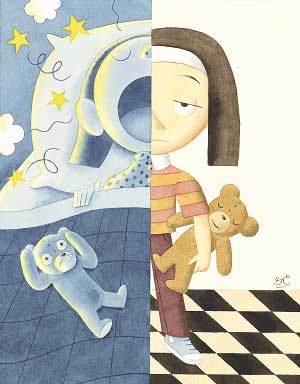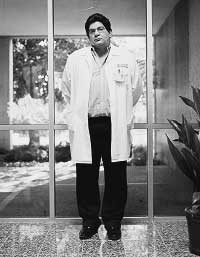 |
|
Relieving a child's sleep troubles can vanquish a whole host of woes
By Krista Conger
Illustration by Gregory Clarke
Photography by Bryce Duffy
Eric was bouncing off the walls of the exam room when Rafael Pelayo, MD, walked in."He has so much more energy now," said his mother with mixed delight and chagrin, disentangling the 7-year-old from the exam room curtain. "He's not sleepy anymore."
Pelayo, a sleep specialist and pediatric neurologist at Lucile Packard Children's Hospital, looked on approvingly as Eric helped himself to the tongue depressors. The two had first become acquainted several months earlier when Eric's mom brought him to Stanford's Sleep Disorders Clinic for a sleep study -- an overnight test that monitors brain waves, breathing and movement in a sleeping subject -- to track down the cause of the night terrors he'd been experiencing since the age of 3. Occasional episodes of night terrors, in which a child appears inconsolably frightened, are not uncommon in young children but Eric's nightly escapades of screaming, crying and even sleepwalking had his parents at the end of their ropes. He was also groggy and lethargic during the day.
It turned out that Eric had a nasty case of sleep apnea that caused him to stop breathing many times each night. The unconscious effort necessary to rouse himself and restore his breathing during each episode robbed him of sleep and contributed to the night terrors.
Pelayo, who is also an assistant professor of psychiatry and of pediatrics at Stanford University School of Medicine, recommended the removal of Eric's tonsils and adenoids -- lumps of flesh in the back of the throat that can block the airway during sleep. He also suggested short-circuiting the night terrors by waking him in the evening about 15 or 20 minutes before an episode usually occurred.
His recommendations worked: Eric slept much better and his night terrors decreased. He also gained 6 pounds and grew several inches taller.
"I couldn't understand why he was so tiny before," said his mother, grabbing Eric as he attempted to jump off a chair. Almost as an aside, she mentioned that Eric was now so energetic his teachers had begun to wonder whether he might have attention deficit hyperactivity disorder. And the night terrors had recently begun worsening, she added.
Pelayo's ears perked up. "Does Eric ever complain about growing pains in his legs?" he asked. "Does he fidget a lot?" When she answered yes, Pelayo described another sleep disorder called restless leg syndrome that seems to be linked to ADHD. He suggested another sleep study for Eric to find out if he might qualify for a groundbreaking multicenter clinical trial at Stanford exploring the link between the syndrome and ADHD.
 |
|
Rafael Pelayo, MD. |
|
Wake-up call
Eric's a lucky boy. True, he suffers from nearly every known sleep disorder -- sleep apnea, restless leg syndrome, night terrors, sleepwalking and insomnia. But his arrival at the clinic has opened the door to some highly effective treatments. Others of his classmates won't be so fortunate.
Recent data suggest that as many as 10 percent of school-age kids have some type of sleep disorder. But the startling array of symptoms exhibited by chronically sleepy kids -- including hyperactivity, growing pains, headaches, inattentiveness and poor school performance -- can easily be misinterpreted or overlooked by parents and doctors. Telltale physical signs like habitual snoring, mouth breathing and nightly tossing and turning are also often dismissed as normal features of growing up.
"Often parents are told not to worry about these things," says Pelayo, who is working to increase awareness of pediatric sleep disorders. "But habitual snoring, learning difficulties and behavioral problems should all raise suspicions of a possible sleep disorder." Although Pelayo encourages pediatricians and specialists to routinely ask about their patients' sleep patterns, the condition remains underdiagnosed.
Deciphering the clues is so difficult that Pelayo and other specialists believe physicians and parents are too often chasing red herrings -- packing kids off to neurologists or psychiatrists instead of focusing on the real culprit. Their conviction is not just idle speculation: A study published in the January 2002 issue of the Journal of Pediatrics indicates that nearly 30 percent of pediatric patients with suspicious neurological symptoms may have problems breathing normally at night, in comparison with about 11 percent of children visiting a pediatrician for other reasons. And about 15 percent of all kids are habitual snorers, a condition strongly linked to sleep-disordered breathing.
"You see patients with sleep disorders every day," said Pelayo in a grand rounds talk to Packard Children's Hospital neurology residents. "If you're not diagnosing it, it's because you're missing it." The physicians' oversight is all too easy to understand in a society that often categorizes sleep as an expendable luxury. But interfering with either the length or the quality of sleep deprives a child of a biological necessity and affects a child's emotional, academic and physical performance.
Fortunately, many problems can be corrected with medication, surgery or a combination of the two. Other problems, such as trouble settling down to sleep or frequent night waking may have psychological roots. "Is the child scared of the dark?" asked Pelayo. "Or do they feel safe and comfortable when they're alone at night?" One way of pinpointing whether the cause is medical or mental is to allow the child to sleep with his or her parents for several days. "If they still sleep horribly, then it's physical," said Pelayo. And as sleepy parents and children both know, poor sleep leads to real suffering.
"Lack of sleep is torture," says Pelayo. "Unlike eating, no one has ever given up sleep as a form of protest." Like Eric, sleepy children often manifest the burning eyes, cloudy thinking and delayed response times that follow a sleepless night in the structured atmosphere of school or family activities.
"Kids who don't sleep well clearly have trouble behaving," says Pelayo. As he discussed with Eric's mother, he and his colleagues at other institutions are conducting a clinical trial to determine whether at least some patients diagnosed with ADHD might instead be poor sleepers. Sleep researchers noted several years ago that children with ADHD were more likely than the general population to suffer from restless leg syndrome. Children and adults with restless leg syndrome have unpleasant crawling sensations in their legs that can be relieved only by movement. The constant nighttime squirming takes its toll, robbing sufferers of precious quality sleep and, the researchers theorize, gives rise to the inattention, hyperactivity and impulsiveness that are also the hallmarks of ADHD.
While the theory has the ring of common sense, proving a cause-and-effect link has been tricky. It's possible that the frequent pairing of the two conditions is simply a coincidence, or that both conditions result from a misfiring of a shared biological pathway in the brain. Their relationship has also been muddied by the fact that the stimulants frequently used to modulate the symptoms of ADHD can also improve the daytime functioning of people with sleep disorders.
The consequences of bad night's sleep
To unravel the mystery, the researchers are recruiting 120 children with ADHD for the three-year study, about half of whom also have restless leg syndrome. Both groups will be treated with a drug for restless leg syndrome and monitored for any improvement in their ability to concentrate, learn and sit still. If only the kids with restless leg syndrome get better, it will be strong proof that at least some cases of ADHD are the direct result of sleep deprivation.
Short of a diagnosis of full-blown ADHD, sleep disorders have also been linked to other learning problems. Another study -- published in the journal Pediatrics in September 1998 -- found that 18 percent of 297 first-grade students performing at the bottom of their class suffered from sleep apnea. The children who had their condition surgically corrected experienced a dramatic improvement in their grades in the following year when compared with their untreated, sleepy peers.
As Eric demonstrated, children with apnea are often also poor growers. The nightly struggle to breathe burns calories better spent on laying down body fat or crafting new bone. One study also found that children with apnea secreted more growth hormone after corrective surgery and their weight, body mass and body fat increased substantially within six months of treatment.
It's obvious that sleep disorders of every flavor are bad news for kids. Although awareness of sleep disorders is slowly increasing [see sidebar], Pelayo still doesn't see enough kids like Eric. He knows they're out there, though.
"We should be treating kids all the time," he says. "But we don't yet get enough referrals." Currently Pelayo splits his clinical time between adults and children. To spread awareness, he gives a regular community lecture to parents called "Sleepless in Silicon Valley" to help them understand their children's sleep habits and identify potential problems.
Eric's mom doesn't need any convincing from Pelayo that it's not just kids who stand to benefit from a good night's rest. "We're here to take care of families," says Pelayo. "And that's what we do."
ABZs of troubled sleep
Signs that spell trouble
Rafael Pelayo, MD, began wondering about sleep and dreaming as a biology major at the University of Puerto Rico. But his interest really blossomed when, as a weary medical student at Albert Einstein College of Medicine, he noticed that the director of the sleep lab at the associated Montefiore Medical Center was arriving at 9 a.m. and leaving at 5 p.m. -- strangely civilized hours for a medical professional.
"This seemed appealing to me," he says. His quest to pursue the nascent field of sleep medicine led him to specialize in neurology and psychiatry, and it was as a pediatric neurologist that he began asking the parents of his young patients an unconventional question: "Does your child snore?"
At first it might seem like noisy sleeping should be the least of his patients' worries. But Pelayo knew that habitual snoring is a hallmark of sleep-disordered breathing: The nocturnal snorts and gasps that many parents and pediatricians regard as normal might indicate a serious medical condition.
"Snoring is never a normal thing to do," says Pelayo, now at Stanford. "It's a much bigger problem than people realize." The American Academy of Pediatrics agrees: Less than a year ago it recommended that pediatricians screen all their patients for snoring as a method of identifying children with obstructive sleep apnea syndrome -- a condition that causes the sleeper to stop breathing up to several hundred times each night, requiring many micro-awakenings to restore airflow. Recent research indicates that around 15 percent of all kids might snore and should be evaluated for sleep problems.
In addition to habitual snoring, Pelayo lists several other signs that might indicate a potential sleep problem:
-
Unrefreshing sleep.
-
Restless sleep.
-
Regular mouth breathing during sleep.
-
Sleeping with head arched back.
-
Noticeable pauses in breathing pattern while asleep.
-
Excessive nighttime sweating or bedwetting.
-
Frequent night terrors or sleep walking.
-
Growing pains in legs during daytime hours, which are associated with restless leg syndrome.
-
Unexplained learning or behavioral problems, such as hyperactivity and irritability.
-
Slow or abnormal growth patterns, sometimes called 'failure to thrive.'
-
Parents, grandparents or siblings with known sleep disorders, such as apnea or restless leg syndrome.
Comments? Contact Stanford Medicine at

